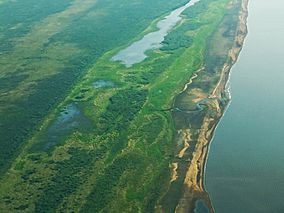Old Crow Flats facts for kids
Quick facts for kids Old Crow Flats |
|
|---|---|
|
IUCN Category IV (Habitat/Species Management Area)
|
|

Shoreline of a large lake in Old Crow Flats
|
|
| Area | 6,170 square kilometres (2,380 sq mi) |
| Designated: | 24 May 1982 |
| Reference #: | 244 |
Old Crow Flats is a 6,170 km2 (2,382 sq mi) wetland complex in northern Yukon, Canada along the Old Crow River. It is north of the Arctic Circle and south of the Beaufort Sea, and is nearly surrounded by mountains.
The archaeological sites in the area demonstrate some of the earliest human habitation in North America.
Site
The site is protected by the Yukon Wildlife Ordinance and Migratory Birds Convention Act. It was identified as part of the International Biological Program inventory, and was designated a wetland of international importance via the Ramsar Convention on May 24, 1982.
The habitat is an important breeding area for aquatic mammals and peregrine falcons, and is also used for summer moulting by waterfowl, as well as an autumn staging site for various species of birds. For this reason, it is considered an Important Bird Area.
Per the Vuntut Gwitchin Final Agreement, the southern extent of Old Crow Flats (approximately 7,785 km²) is classified as a Special Management Area by the Yukon Government; the northern portion is now part of Vuntut National Park. Old Crow Flats contains more than 2,000 ponds and marshes.
Archaeology
"The area includes some of the richest archaeological sites of early human habitation in North America". More than 20,000 fossils have been collected in the area, including some never before reported in North America.
The Bluefish Caves, another important area with early human presence, are located about 75 km southwest of the Old Crow Flats.
Fossils and artifacts
Many northern Yukon rivers, including Old Crow River and Porcupine River, changed course relatively recently, and cut through the fossil-bearing deposits. As a result, millions of fossils were eroded from the bluffs and redeposited in new riverbanks.
Many fascinating animals are represented by these fossils. They include "mammoths, mastodons, giant beavers, ground sloths, camels, several kinds of horses, giant bison, short-faced bears, American lions, short-faced skunks and many more."
"Some of the mammoth bones are broken in distinctive ways reminiscent of human butchery and tool production, and a selection of these yielded radiocarbon dates between 25 000 and 40 000 years old."

